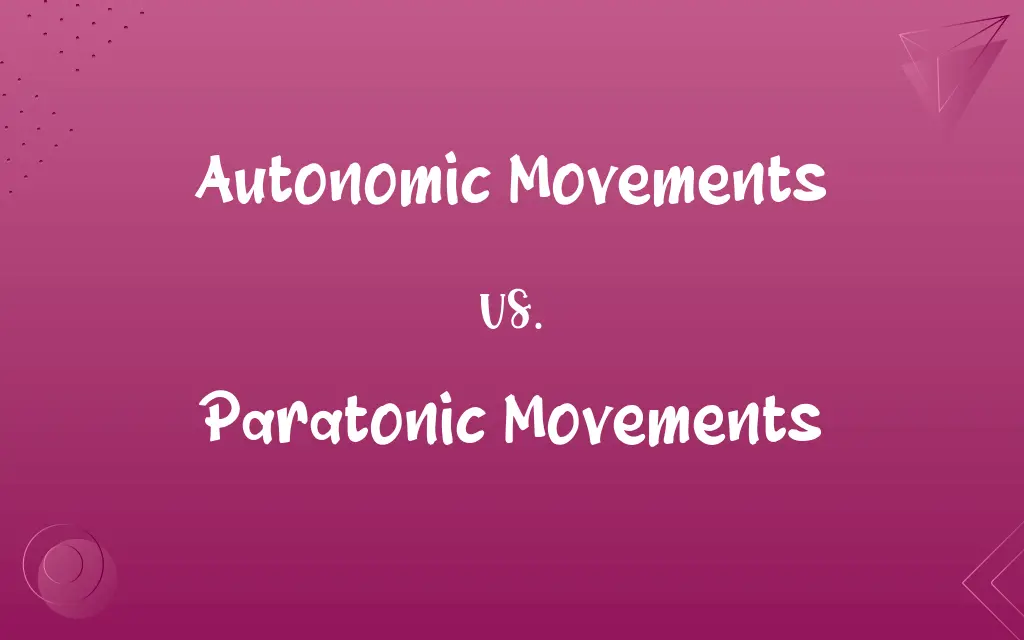Autonomic Movements vs. Paratonic Movements: Know the Difference

By Shumaila Saeed || Published on January 29, 2024
Autonomic Movements are involuntary and self-regulated body functions. Paratonic Movements involve resistance against passive movement due to muscle tone.

Key Differences
Autonomic Movements refer to involuntary physiological activities controlled by the autonomic nervous system, like heartbeat and digestion. In contrast, Paratonic Movements are characterized by resistance in muscles when an external force tries to move a body part, often observed in neurological evaluations.
Shumaila Saeed
Jan 29, 2024
While Autonomic Movements are crucial for maintaining homeostasis and occur without conscious control, Paratonic Movements represent a physical response to external manipulation and are used as a diagnostic tool to assess muscle tone and neurological function.
Shumaila Saeed
Jan 29, 2024
Autonomic Movements are essential for survival, regulating internal organs and systems seamlessly. Paratonic Movements, however, signify the muscle's reaction to being moved passively and can indicate abnormalities in muscle tone or neurological disorders.
Shumaila Saeed
Jan 29, 2024
The smooth functioning of Autonomic Movements is a marker of a healthy autonomic nervous system. Paratonic Movements, if abnormal, can point to issues like increased muscle tone or rigidity, often seen in conditions like Parkinson's disease.
Shumaila Saeed
Jan 29, 2024
In summary, Autonomic Movements operate silently in the background, maintaining bodily functions, while Paratonic Movements are observable during physical examinations and can provide insights into the state of muscle and neurological health.
Shumaila Saeed
Jan 29, 2024
ADVERTISEMENT
Comparison Chart
Control Mechanism
Involuntary, controlled by the autonomic nervous system
Occur in response to passive movement, indicating muscle tone
Shumaila Saeed
Jan 29, 2024
Function
Regulate vital functions like heart rate, digestion
Indicate muscle tone and neurological function
Shumaila Saeed
Jan 29, 2024
Conscious Awareness
Not consciously controlled or felt
Felt as resistance during passive movement
Shumaila Saeed
Jan 29, 2024
Role in Health
Essential for homeostasis and survival
Used to assess neurological health and muscle condition
Shumaila Saeed
Jan 29, 2024
Examples
Heartbeat, peristalsis in the gut
Resistance felt during limb manipulation in a neurological exam
Shumaila Saeed
Jan 29, 2024
ADVERTISEMENT
Autonomic Movements and Paratonic Movements Definitions
Autonomic Movements
Involuntary actions performed by organs and glands.
The dilation of pupils in dim light is an autonomic movement.
Shumaila Saeed
Jan 04, 2024
Paratonic Movements
Indicators of muscle tone and neurological health.
A patient's leg showing resistance when lifted indicates a paratonic movement.
Shumaila Saeed
Jan 04, 2024
Autonomic Movements
Internal mechanisms operating without conscious control.
Digestion is an autonomic movement that occurs after eating.
Shumaila Saeed
Jan 04, 2024
Paratonic Movements
Muscle response to external manipulation in a clinical setting.
During a neurological exam, the stiffness in limbs can be a sign of paratonic movement.
Shumaila Saeed
Jan 04, 2024
Autonomic Movements
Self-regulated processes maintaining body homeostasis.
Sweating to cool the body is an autonomic movement.
Shumaila Saeed
Jan 04, 2024
ADVERTISEMENT
Paratonic Movements
Physical signs of muscle condition and function.
Increased rigidity in arm muscles during movement can be a form of paratonic movement.
Shumaila Saeed
Jan 04, 2024
Autonomic Movements
Automatic bodily functions regulated by the nervous system.
Breathing is an autonomic movement that occurs without conscious thought.
Shumaila Saeed
Jan 04, 2024
Paratonic Movements
Resistance in muscles during passive movement.
When the doctor moves a patient's arm, the slight resistance felt is a paratonic movement.
Shumaila Saeed
Jan 04, 2024
Autonomic Movements
Unconscious physiological activities essential for life.
The heart's continuous beating is an autonomic movement.
Shumaila Saeed
Jan 04, 2024
Paratonic Movements
Reflective movements in response to passive force.
In a physical therapy session, the resistance while moving a joint is a paratonic movement.
Shumaila Saeed
Jan 04, 2024
Repeatedly Asked Queries
What are Autonomic Movements?
They are involuntary functions controlled by the autonomic nervous system.
Shumaila Saeed
Jan 29, 2024
Are breathing and digestion Autonomic Movements?
Yes, they are classic examples.
Shumaila Saeed
Jan 29, 2024
Can we control Autonomic Movements?
No, they occur without conscious control.
Shumaila Saeed
Jan 29, 2024
What signifies a problem with Autonomic Movements?
Irregularities like abnormal heart rate or digestive issues.
Shumaila Saeed
Jan 29, 2024
What are Paratonic Movements?
Resistance in muscles during passive movement.
Shumaila Saeed
Jan 29, 2024
Are Paratonic Movements always abnormal?
No, they can be normal, but changes may indicate problems.
Shumaila Saeed
Jan 29, 2024
Are Paratonic Movements voluntary?
No, they are involuntary responses to external manipulation.
Shumaila Saeed
Jan 29, 2024
Can Paratonic Movements indicate health issues?
Yes, abnormalities can suggest neurological disorders.
Shumaila Saeed
Jan 29, 2024
Can exercise influence Autonomic Movements?
Yes, it can improve functions like heart rate variability.
Shumaila Saeed
Jan 29, 2024
Can physical therapy affect Paratonic Movements?
Yes, it can help in managing and understanding these movements.
Shumaila Saeed
Jan 29, 2024
Is muscle stiffness a Paratonic Movement?
Yes, when it occurs in response to passive movement.
Shumaila Saeed
Jan 29, 2024
How are Autonomic Movements tested?
Through various medical tests like EKG for heart activity.
Shumaila Saeed
Jan 29, 2024
Can medication affect Autonomic Movements?
Yes, some medications can influence these involuntary functions.
Shumaila Saeed
Jan 29, 2024
Can anxiety affect Autonomic Movements?
Yes, it can impact functions like heart rate.
Shumaila Saeed
Jan 29, 2024
Are all involuntary movements Autonomic Movements?
Most are, but some like reflexes have different mechanisms.
Shumaila Saeed
Jan 29, 2024
Do Paratonic Movements always indicate disease?
Not always, but they can be a sign of muscle or nerve issues.
Shumaila Saeed
Jan 29, 2024
Is pupil dilation an Autonomic Movement?
Yes, it happens automatically in response to light.
Shumaila Saeed
Jan 29, 2024
Is blood pressure regulation an Autonomic Movement?
Yes, it's maintained by the autonomic nervous system.
Shumaila Saeed
Jan 29, 2024
Are Paratonic Movements present in healthy individuals?
Yes, but they are typically more pronounced in certain conditions.
Shumaila Saeed
Jan 29, 2024
Share this page
Link for your blog / website
HTML
Link to share via messenger
About Author
Written by
Shumaila SaeedShumaila Saeed, an expert content creator with 6 years of experience, specializes in distilling complex topics into easily digestible comparisons, shining a light on the nuances that both inform and educate readers with clarity and accuracy.









































































